South Dakota State Gemstone or Gem
Fairburn Agate
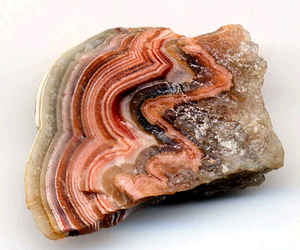
(Microcrystalline Quartz)
Adopted on February 11, 1966.
The Fairburn agate, Microcrystalline Quartz, was designated as South Dakota's state gemstone on February 11, 1966.
The South Dakota Department of Environment and Natural Resources (DENR) does not keep statistics on the Fairburn agate.
Fairburn Agate: South Dakota State Gemstone
What Is A Geode?
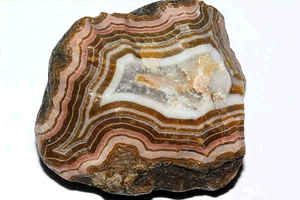
A geode is simply a hollow, irregularly rounded rock with inward-pointing crystals. The term may also be used to describe a crystal-lined cavity. The origin of geodes is a two-fold process: first, the origin of the cavity; and second, the filling of the cavity. Geodes may form in virtually any rock type. For example, in igneous (volcanic) rocks, cavities are created by gases. Volcanic lava contains dissolved gases that are held in the molten rock by confining pressure. As with soda pop, as soon as the pressure is reduced (when the magma erupts) the gases begin to escape. As the lava quickly cools and hardens, the cavities may remain as "frozen" pores in the rock. Cavities can range from the size of a pea to openings 10 feet by 30 feet (3 by 9.1 meters) (Sanborn, 1976).
In all cases, the cavity in a rock may be slowly filled with mineral material. Mineral growth proceeds inward toward the center. Therefore, the youngest crystals are near the middle (Hayes, 1964). The original hollow area may be completely filled with mineral matter (thereby forming a nodule) or partially filled, forming a geode .
The mineral matter that fills the cavities comes from ground water passing through the rock. Water contains dissolved matter such as silicon, oxygen, calcium, and carbonate. Under certain conditions, these chemicals precipitate out of the water, forming a solid mineral that is deposited inside the cavities. (This is the same manner in which lime builds up on a stalactite , or on the inside of a tea pot.) One of the most common types of mineral matter filling nodules and geodes is silica, in the form of agate.
What Is A Fairburn Agate?
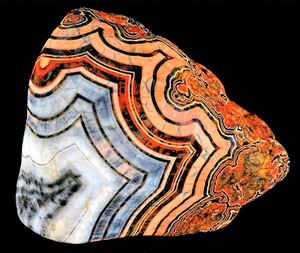
Agates, in nodules and geodes, are some of the most popular varieties of silica. Agate forms under sedimentary conditions. Whitlock (1946) states as an analogy that the quartz varieties are like six-sided snow crystals, and agates are like rounded icicles of freezing water. Agates consist of alternating layers of fibrous chalcedony with circular to semicircular layers, patterns, or bands like rings of targets. These layers may be composed of different thicknesses and colors. The layers are usually concentric and parallel to the walls of the rock cavity in which they are deposited. Fairburn agates are formed in this way.
Fairburn agates are noted for their strikingly contrasted, thin bands of wonderful natural colors (Sanborn, 1976). Roberts and Rapp (1965) state that the color patterns are generally yellowish-brown with narrow opaque white bands, or dark red with white bands. However, another beautiful combination shows salmon-pink bands alternating with white bands. Other colors included in these agates are black, yellow, grayish-blue and milky-pink.
Where Are They Found?
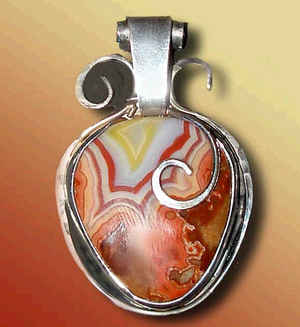
In the literature, Fairburn agates are reported as quite scarce, and highly prized by collectors (Campbell and Roberts, 1985). The price of a Fairburn agate ranges up to $150, depending on the size and quality of the geode (Eric Fritzsch, Geology Museum, South Dakota School of Mines and Technology, personal communication, July, 1993). As with other agates, a larger Fairburn agate is not necessarily a better-quality agate. Agates are primarily used as decorative pieces, as mineral specimens, and in lapidary work.
The state gemstone is the Fairburn agate, a semiprecious stone first discovered near Fairburn, South Dakota. The stone is found primarily in an area extending from Orella, Neb., to Farmingdale, S.D. It is used in jewelry and is a favorite of rock collectors.
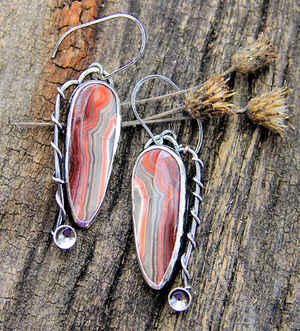
Fairburn agates are noted for their strikingly contrasted, thin bands of wonderful natural colors (Sanborn, 1976). Roberts and Rapp (1965) state that the color patterns are generally yellowish-brown with narrow opaque white bands, or dark red with white bands. However, another beautiful combination shows salmon-pink bands alternating with white bands. Other colors included in these agates are black, yellow, grayish-blue and milky-pink.
These agates were originally named after a prolific locality 10 miles east of Fairburn, South Dakota, in the southern Black Hills area. According
to Roberts and Rapp (1965), Fairburn agates occur in a broad elliptical belt extending from Creston in Pennington County, South Dakota, to near Orella
in Sioux County, Nebraska, with the maximum width approaching 15 miles near Red Shirt, South Dakota. According to Fritzsch (S.D. School of Mines and
Technology, personal communication, 1993), the area is more restricted. The Fairburn agate fields cover thousands of acres of very stony land and most
of it is rugged terrain, well decorated with cactus, weeds, and cedar trees (Zeitner, 1964).
Fairburn agates may be collected around the Fairburn area where they are scattered on the ground surface. There is no company that collects and markets
Fairburn agate.
Agate, like Chalcedony, is a variety of quartz gemstones composed of layers of quartz, sometimes of different colors. Agate usually occurs as rounded nodules or veins in rock such as volcanic lava. The layers of quartz are often concentric. The composition of agate varies greatly, but silica is always predominant, usually with alumina and oxide of iron. Agate comes in most colors. There are several types of agate. Common ones are: blue lace agate, moss agate, tree agate and petrified wood.
South Dakota Law
The law designating the rose quartz as the official South Dakota state gemstone is found in the South Dakota Codified Laws , title 1, chapter 1-6, section 1-6-12.
TITLE 1 STATE AFFAIRS AND GOVERNMENT
CHAPTER 1-6 STATE EMBLEMS
1-6-12 State mineral stone and gemstone.
1-6-12. State mineral stone and gemstone. The mineral stone known as the rose quartz is hereby designated as the official state mineral stone of the
State of South Dakota, and the Fairburn agate is hereby designated as the official state gemstone of the State of South Dakota.
Source: SL 1966, ch 175.
Minerals, & Gems

Gemstone, Minerals, Rocks







